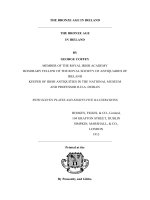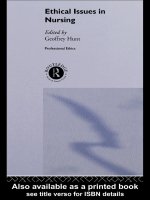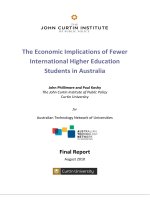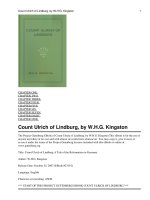LITERATURE USA IN BRIEF ppt
Bạn đang xem bản rút gọn của tài liệu. Xem và tải ngay bản đầy đủ của tài liệu tại đây (400.44 KB, 56 trang )
LITERATURE
I N B R I E F
U S A
Literature
EXECUTIVE EDITOR: GEORGE CLACK • AUTHOR: KATHRYN VANSPANCKEREN •
EDITOR: PAUL MALAMUD • DESIGNER: CHLOE D. ELLIS
• COVER ILLUSTRATION SALLY VITSKY • COVER DESIGN MIN YAO
In Brief
U.S.A.
1
ABOUT THE AUTHOR
K
athryn VanSpanckeren, professor of English at the University
of Tampa, has lectured in American literature widely abroad,
and is former director of the Fulbright-sponsored Summer
Institute in American Literature for international scholars. Her
publications include poetry and scholarship. She received her
Bachelors degree from the University of California, Berkeley, and
her Ph.D. from Harvard University.
T
he foundation of American literature begins with the
orally transmitted myths, legends, tales, and lyrics (always
songs) of Indian cultures. Native American oral tradition is
quite diverse. Indian stories glow with reverence for nature
2
CHAPTER 1
EARLY AMERICAN WRITING
“The First Thanksgiving, 1621,” by J.L.G. Ferris, depicts America’s early settlers and Native
Americans celebrating a bountiful harvest. Courtesy Library of Congress.
as a spiritual, as well as physical, mother. Nature is alive and
endowed with spiritual forces; main characters may be animals
or plants, often totems associated with a tribe, group, or
individual.
The Indian contribution to America is greater than is often
believed. The hundreds of Indian words in everyday American
English include “canoe,” “tobacco,” “potato,” “moccasin,”
“moose,” “persimmon,” “raccoon,” “tomahawk,” and “totem.”
Contemporary Native American writing, discussed in chapter 8,
also contains works of great beauty.
The rst European record of exploration in America is in a
Scandinavian language. The Old Norse Vinland Saga recounts
how the adventurous Leif Eriksson and a band of wandering
Norsemen settled briey somewhere on the northeast coast of
America—probably Nova Scotia, in Canada—in the rst decade
of the 11th century.
The rst known and sustained contact between the
Americas and the rest of the world, however, began with the
famous voyage of an Italian explorer, Christopher Columbus,
funded by the Queen of Spain, Isabella. Columbus’s journal in
his “Epistola,” printed in 1493, recounts the trip’s drama.
Initial English attempts at colonization were disasters. The
rst colony was set up in 1585 at Roanoke, o the coast of North
Carolina; all its colonists disappeared. The second colony was
more permanent: Jamestown, established in 1607. It endured
3
4
starvation, brutality, and misrule. However, the literature of the
period paints America in glowing colors as the land of riches
and opportunity. Accounts of the colonizations became world-
renowned.
In the 17th century, pirates, adventurers, and explorers
opened the way to a second wave of permanent colonists,
bringing their wives, children, farm implements, and
craftsmen’s tools. The early literature of exploration is made up
of diaries, letters, travel journals, ships’ logs, and reports to the
explorers’ nancial backers. Because England eventually took
possession of the North American colonies, the best known and
most anthologized colonial literature is English.
It is likely that no other colonists in the history of the
world were as intellectual as the Puritans, most of them of
English or Dutch origin. Between 1630 and 1690, there were
as many university graduates in the northeastern section of
the United States, known as New England, as in England. The
self-made and often self-educated Puritans wanted education
to understand and execute God’s will as they established their
colonies throughout New England.
Puritan style varied enormously—from complex
metaphysical poetry to homely journals and crushingly
pedantic religious history. Whatever the style or genre, certain
themes remained constant. Life was seen as a test; failure led to
eternal damnation and hellre, and success to heavenly bliss.
4
This world was an arena of constant battle between the forces
of God and the forces of Satan, a formidable enemy with many
disguises.
Scholars have long pointed out the link between Puritanism
and capitalism: Both rest on ambition, hard work, and an
intense striving for success. Although individual Puritans could
not know, in strict theological terms, whether they were “saved”
and among the elect who would go to heaven, Puritans tended
to feel that earthly success was a sign of election. Wealth and
status were sought not only for themselves, but as welcome
reassurances of spiritual health and promises of eternal life.
Moreover, the concept of stewardship encouraged success.
The Puritans felt that in advancing their own prot and their
community’s well-being, they were also furthering God’s plans.
The great model of writing, belief, and conduct was the Bible,
in an authorized English translation. The great antiquity of the
Bible made it authoritative to Puritan eyes.
As the 1600s wore on into the 1700s, religious dogmatism
gradually dwindled, despite sporadic, harsh Puritan eorts to
stem the tide of tolerance. The spirit of toleration and religious
freedom that gradually grew in the American colonies was
rst established in Rhode Island and Pennsylvania, home of
the Quakers. The humane and tolerant Quakers, or “Friends,”
as they were known, believed in the sacredness of the
individual conscience as the fountainhead of social order and
5
6 7
morality. The fundamental Quaker belief in universal love and
brotherhood made them deeply democratic and opposed to
dogmatic religious authority. Driven out of strict Massachusetts,
which feared their inuence, they established a very successful
colony, Pennsylvania, under William Penn in 1681.
6 7
T
he hard-fought American Revolution against Britain
(1775-1783) was the rst modern war of liberation against
a colonial power. The triumph of American independence
seemed to many at the time a divine sign that America and her
people were destined for greatness. Military victory fanned
nationalistic hopes for a great new literature. Yet, with the
exception of outstanding political writing, few works of note
appeared during or soon after the Revolution.
Americans were painfully aware of their excessive
dependence on English literary models. The search for a native
literature became a national obsession. America’s literary
independence was slowed by a lingering identication with
England, an excessive imitation of English or classical literary
models, and dicult economic and political conditions that
hampered publishing.
CHAPTER 2
LITERARY INDEPENDENCE
8 9
JAMES FENIMORE COOPER, like
Washington Irving, was one of the
rst great American writers. Like other
Romantic writers of the era, he evoked
a sense of the past (in his day, the
American wilderness that had preceded
and coincided with early European
settlement). In Cooper, one nds the
powerful myth of a “golden age” and the
poignance of its loss.
While Washington Irving and other American writers before
and after him scoured Europe in search of its legends, castles,
and great themes, Cooper helped create the essential myth
of America: European history in America was a re-enactment
of the Fall in the Garden of Eden. The cyclical realm of nature
was glimpsed only in the act of destroying it: The wilderness
disappeared in front of American eyes, vanishing before the
oncoming pioneers like a mirage. This is Cooper’s basic tragic
vision of the ironic destruction of the wilderness—the “new
Eden” that had attracted the colonists in the rst place.
The son of a Quaker family, he grew up on his father’s
remote estate at Otsego Lake (now Cooperstown) in central
New York State. Although this area was relatively peaceful
during Cooper’s boyhood, it had once been the scene of an
Indian massacre. Young Fenimore Cooper saw frontiersmen and
James Fenimore Cooper
1789-1851
8 9
Indians at Otsego Lake as a boy; in later life, bold white settlers
intruded on his land.
Natty Bumppo, Cooper’s renowned literary character,
embodies his vision of the frontiersman as a gentleman, a
Jeersonian “natural aristocrat.” Early in 1823, in The Pioneers,
Cooper had begun to imagine Bumppo. Natty is the rst famous
frontiersman in American literature, and the literary forerunner
of countless ctional cowboy and backwoods heroes. He is the
idealized, upright individualist who is better than the society
he protects. Poor and isolated, yet pure, he is a touchstone for
ethical values, and pregures Herman Melville’s Billy Budd and
Mark Twain’s Huck Finn.
Based in part on the real life of American pioneer Daniel
Boone—who was a Quaker like Cooper—Natty Bumppo,
an outstanding woodsman like Boone, was a peaceful man
adopted by an Indian tribe. Both Boone and the ctional
Bumppo loved nature and freedom. They constantly kept
moving west to escape the oncoming settlers they had guided
into the wilderness, and they became legends in their own
lifetimes.
The unifying thread of the ve novels collectively known
as the Leather-Stocking Tales is the life of Natty Bumppo.
Cooper’s nest achievement, they constitute a vast prose epic
with the North American continent as setting, Indian tribes as
major actors, and great wars and westward migration as social
10 11
background. The novels bring to life frontier America from
1740 to 1804. Cooper’s novels portray the successive waves
of the frontier settlement: the original wilderness inhabited
by Indians; the arrival of the rst whites as scouts, soldiers,
traders, and frontiersmen; the coming of the poor, rough settler
families; and the nal arrival of the middle class, bringing the
rst professionals—the judge, the physician, and the banker.
Each incoming wave displaced the earlier: Whites displaced the
Indians, who retreated westward; the “civilized” middle classes
who erected schools, churches, and jails displaced the lower-
class individualistic frontier folk, who moved further west, in
turn displacing the Indians who had preceded them. Cooper
evokes the endless, inevitable wave of settlers, seeing not only
the gains but the losses.
Like Rudyard Kipling, E.M. Forster, Herman Melville, and
other sensitive observers of widely varied cultures interacting
with each other, Cooper was a cultural relativist. He understood
that no culture had a monopoly on virtue or renement.
10 11
T
he Romantic movement, which originated in Germany but
quickly spread, reached America around the year 1820.
Romantic ideas centered around the spiritual and aesthetic
dimension of nature, and the importance of the individual mind
and spirit. The Romantics underscored the importance of self-
expressive art for the individual and society.
The development of the self became a major theme; self-
awareness a primary method. If, according to Romantic theory,
self and nature were one, self-awareness was not a selsh
dead-end but a mode of knowledge opening up the universe.
If one’s self were one with all humanity, then the individual had
a moral duty to reform social inequalities and relieve human
suering. The idea of “self,” which suggested selshness to
earlier generations, was redened. New compound words with
positive meanings emerged: “self-realization,” “self-expression,”
“self-reliance.”
As the unique, subjective self became important, so did the
realm of psychology. Exceptional artistic eects and techniques
CHAPTER 3
NEW ENGLAND ROMANTICISM
12 13
The protest against British taxes known as the “Boston Tea Party,” 1773.
were developed to evoke heightened psychological states. The
“sublime”—an eect of beauty in grandeur (for example, a view
from a mountaintop)—produced feelings of awe, reverence,
vastness, and a power beyond human comprehension.
Romanticism was armative and appropriate for
most American poets and creative essayists. America’s vast
mountains, deserts, and tropics embodied the sublime.
The Romantic spirit seemed particularly suited to American
democracy: It stressed individualism, armed the value of the
common person, and looked to the inspired imagination for its
aesthetic and ethical values.
Transcendentalism
The Transcendentalist movement, embodied by essayists
Ralph Waldo Emerson and Henry David Thoreau, was a reaction
against 18th century Rationalism, and closely linked to the
Romantic movement. It is closely associated with Concord,
Massachusetts, a town near Boston, where Emerson, Thoreau,
and a group of other writers lived.
In general, Transcendentalism was a liberal philosophy
favoring nature over formal religious structure, individual
insight over dogma, and humane instinct over social
convention. American Transcendental Romantics pushed radical
individualism to the extreme. American writers—then or later
—often saw themselves as lonely explorers outside society
12 13
and convention. The American hero—like Herman Melville’s
Captain Ahab, or Mark Twain’s Huck Finn—typically faced risk,
or even certain destruction, in the pursuit of metaphysical self-
discovery. For the Romantic American writer, nothing was a
given. Literary and social conventions, far from being helpful,
were dangerous. There was tremendous pressure to discover an
authentic literary form, content, and voice.
RALPH WALDO EMERSON, the towering
gure of his era, had a religious sense of
mission. Although many accused him
of subverting Christianity, he explained
that, for him “to be a good minister, it
was necessary to leave the church.” The
address he delivered in 1838 at his alma
mater, the Harvard Divinity School, made
him unwelcome at Harvard for 30 years.
In it, Emerson accused the church of
emphasizing dogma while stiing the spirit.
Emerson is remarkably consistent in his call for the birth of
American individualism inspired by nature. In Nature (1836), his
rst publication, the essay opens:
Our age is retrospective. It builds the sepulchers
of the fathers. It writes biographies, histories,
criticism. The foregoing generations beheld God
and nature face to face; we [merely] through their
Ralph Waldo Emerson
1803-1882
14 15
Artist’s depiction of the rst shots of the American Revolution, red at Lexington,
Massachusetts, on April 19, 1775. Local militia confronted British troops marching to seize
colonial armaments in the nearby town of Concord.
eyes. Why should not we also enjoy an original
relation to the universe? Why should not we have a
poetry of insight and not of tradition, and a religion
by revelation to us, and not the history of theirs.
Embosomed for a season in nature, whose oods of
life stream around and through us, and invite us by
the powers they supply, to action proportioned to
nature, why should we grope among the dry bones
of the past ?
Much of his spiritual insight comes from his readings in
Hinduism, Confucianism, and Islamic Susm.
HENRY DAVID THOREAU was born in
Concord and made it his permanent
home. From a poor family, like Emerson,
he worked his way through Harvard.
Thoreau’s masterpiece, Walden, or Life in
the Woods (1854), is the result of two years,
two months, and two days (from 1845 to
1847) he spent living in a cabin he built
at Walden Pond, near Concord. This long
poetic essay challenges the reader to
examine his or her life and live it authentically.
Thoreau’s essay “Civil Disobedience,” with its theory
of passive resistance based on the moral necessity for the
just individual to disobey unjust laws, was an inspiration for
Henry David Thoreau
1817-1862
14 15
Mahatma Gandhi’s Indian independence movement and Martin
Luther King’s struggle for black Americans’ civil rights in the
20th century.
Born on Long Island, New York,
WALT WHITMAN was a part-time carpenter
and man of the people, whose brilliant,
innovative work expressed the country’s
democratic spirit. Whitman was largely
self-taught; he left school at the age
of 11 to go to work, missing the sort of
traditional education that made most
American authors respectful imitators
of the English. His Leaves of Grass (1855),
which he rewrote and revised throughout his life, contains
“Song of Myself,” the most stunningly original poem ever
written by an American.
The poem’s innovative, unrhymed, free-verse form, open
celebration of sexuality, vibrant democratic sensibility, and
extreme Romantic assertion that the poet’s self was one with
the universe and the reader, permanently altered the course of
American poetry.
Walt Whitman
1819-1892
16 17
EMILY DICKINSON is, in a sense, a
link between her era and the literary
sensitivities of the 20th century. A radical
individualist, she was born and spent
her life in Amherst, Massachusetts, a
small village. She never married, and
she led an unconventional life that was
outwardly uneventful but was full of
inner intensity. She loved nature and
found deep inspiration in the birds,
animals, plants, and changing seasons of
the New England countryside. Dickinson
spent the latter part of her life as a recluse, due to an extremely
sensitive psyche and possibly to make time for writing.
Dickinson’s terse, frequently imagistic style is even more
modern and innovative than Whitman’s. She sometimes shows
a terrifying existential awareness. Her clean, clear, chiseled
poems, rediscovered in the 1950s, are some of the most
fascinating and challenging in American literature.
Emily Dickinson
(1830-1886)
16 17
W
alt Whitman, Herman Melville, Emily Dickinson—as
well as their contemporaries, Nathaniel Hawthorne and
Edgar Allen Poe—represent the rst great literary generation
produced in the United States. In the case of ction writers, the
Romantic vision tended to express itself in the form Hawthorne
called the “Romance,” a heightened, emotional, and symbolic
form of the novel. As dened by Hawthorne, Romances were
not love stories, but serious novels that used special techniques
to communicate complex and subtle meanings.
Instead of carefully dening realistic characters through a
wealth of detail, as most English or continental novelists did,
Hawthorne, Melville, and Poe shaped heroic gures larger than
life, burning with mythic signicance. The typical protagonists
of the American Romance are haunted, alienated individuals.
Hawthorne’s Arthur Dimmesdale or Hester Prynne in The Scarlet
Letter, Melville’s Ahab in Moby-Dick, and the many isolated and
obsessed characters of Poe’s ales are lonely protagonists pitted
against unknowable, dark fates that, in some mysterious way,
grow out of their deepest unconscious selves. The symbolic
CHAPTER 4
THE FIRST GREAT NOVELISTS
18 19
plots reveal hidden actions of the anguished spirit.
One reason for this ctional exploration into the hidden
recesses of the soul was the absence at the time of settled
community. English novelists—Jane Austen, Charles Dickens
(the great favorite), Anthony Trollope, George Eliot, William
Thackeray—lived in a complex, well-articulated, traditional
society and shared, with their readers, attitudes that informed
their realistic ction.
American novelists were faced with a history of strife and
revolution, a geography of vast wilderness, and a uid and
relatively classless democratic society. Many English novels
show a poor main character rising on the economic and social
ladder, perhaps because of a good marriage or the discovery
of a hidden aristocratic past. But this plot does not challenge
the aristocratic social structure of England. On the contrary,
it conrms it. The rise of the main character satises the wish
fulllment of the mainly middle-class readers of those days in
England.
In contrast, the American novelist had to depend on his or
her own devices. America was, in part, an undened, constantly
moving frontier populated by immigrants speaking various
languages and following strange and crude ways of life. Thus,
the main character in an American story might nd himself
alone among cannibal tribes, as in Melville’s Typee, or exploring
a wilderness like James Fenimore Cooper’s Leatherstocking,
18 19
or witnessing lonely visions from the grave, like Poe’s solitary
individuals,—or meeting the devil walking in the forest, like
Hawthorne’s Young Goodman Brown. Virtually all the great
American protagonists have been “loners.” The democratic
American individual had, as it were, to invent himself. The
serious American novelist had to invent new forms as well:
hence the sprawling, idiosyncratic shape of Melville’s novel
Moby-Dick and Poe’s dreamlike, wandering Narrative of Arthur
Gordon Pym.
HERMAN MELVILLE was a descendant of
an old, wealthy family that fell abruptly
into poverty upon the death of the father.
Despite his upbringing, family traditions,
and hard work, Melville found himself
with no college education. At 19, he went
to sea. His interest in sailors’ lives grew
naturally out of his own experiences, and
most of his early novels grew out of his
voyages. His rst book, Typee, was based
on his time spent among the Taipis people in the Marquesas
Islands of the South Pacic.
Moby-Dick; or, The Whale, Melville’s masterpiece, is the epic
story of the whaling ship Pequod and its captain, Ahab, whose
obsessive quest for the white whale, Moby-Dick, leads the ship
and its men to destruction. This work, a seemingly realistic
Herman Melville
1819-1891
20 21
adventure novel, contains a series of meditations on the human
condition.
Whaling, throughout the book, is a grand metaphor for the
pursuit of knowledge. Although Ahab’s quest is philosophical,
it is also tragic. Despite his heroism, Ahab is doomed and
perhaps damned in the end. Nature, however beautiful, remains
alien and potentially deadly. In Moby-Dick, Melville challenges
Emerson’s optimistic idea that humans can understand nature.
Moby-Dick, the great white whale, is an inscrutable, cosmic
existence that dominates the novel, just as he obsesses Ahab.
Facts about the whale and whaling cannot explain Moby-Dick;
on the contrary, the facts themselves tend to dissolve into
symbols. Behind Melville’s accumulation of facts is a mystic
vision—but whether this vision is evil or good, human or
inhuman, is not explained.
Ahab insists on imaging a heroic, timeless world of
absolutes. Unwisely, he demands a nished “text,” an answer.
But the novel shows that just as there are no nished texts,
there are no nal answers except, perhaps, death. Certain
literary references resonate throughout the novel. Ahab, named
for an Old Testament king, desires a total, Faustian, god-like
knowledge. Like Oedipus in Sophocles’ play, who pays tragically
for wrongful knowledge, Ahab is struck blind before he is nally
killed.
20 21
Ahab’s ship Pequod is named for an extinct New England
Indian tribe; thus the name suggests that the boat is doomed
to destruction. Whaling was in fact a major industry, especially
in New England: It supplied whale oil as an energy source,
especially for lamps. Thus the whale does literally “shed light”
on the universe. The book has historical resonance. Whaling was
inherently expansionist and linked with the historical idea of a
“manifest destiny” for Americans, since it required Americans
to sail round the world in search of whales (in fact, the present
state of Hawaii came under American domination because it
was used as the major refueling base for American whaling
ships). The Pequod’s crew members represent all races and
various religions, suggesting the idea of America as a universal
state of mind, as well as a melting pot. Finally, Ahab embodies
the tragic version of democratic American individualism. He
asserts his dignity as an individual and dares to oppose the
inexorable external forces of the universe.
22 23
T
he U.S. Civil War (1861-1865) between the industrial North
and the agricultural, slave-owning South was a watershed
in American history. Before the war, idealists championed
human rights, especially the abolition of slavery; after the war,
Americans increasingly idealized progress and the “self-made
man.” This was the era of the millionaire manufacturer and the
speculator, when the Darwinian theory of biological evolution
and the “survival of the ttest” species was applied to society
and seemed to sanction the sometimes unethical methods of
the successful business tycoon.
Business boomed after the war. The new intercontinental
rail system, inaugurated in 1869, and the transcontinental
telegraph, which began operating in 1861, gave industry access
to materials, markets, and communications. The constant
inux of immigrants provided a seemingly endless supply of
inexpensive labor as well. Over 23 million foreigners—German,
Scandinavian, and Irish in the early years, and increasingly
Central and Southern Europeans thereafter—owed into the
United States between 1860 and 1910. In 1860, most Americans
CHAPTER 5
THE RISE OF REALISM
22 23
had lived on farms or in small villages, but by 1919 half of the
population was concentrated in about 12 cities.
Problems of urbanization and industrialization appeared:
poor and overcrowded housing, unsanitary conditions, low
pay (called “wage slavery”), dicult working conditions,
and inadequate restraints on business. Labor unions grew,
and strikes brought the plight of working people to national
awareness. Farmers, too, saw themselves struggling against the
“money interests” of the East. From 1860 to 1914, the United
States was transformed from a small, agricultural ex-colony to
a huge, modern, industrial nation. A debtor nation in 1860, by
1914 it had become the world’s wealthiest state. By World War I,
the United States had become a major world power.
As industrialization grew, so did alienation. The two
greatest novelists of the period—Mark
Twain and Henry James—responded
dierently. Twain looked South and
West into the heart of rural and frontier
America for his dening myth; James
looked back at Europe in order to assess
the nature of newly cosmopolitan
Americans.
SAMUEL CLEMENS, better known by
his pen name of MARK TWAIN, grew up
in the Mississippi River frontier town of
Samuel Clemens
(Mark Twain) 1835-1910









